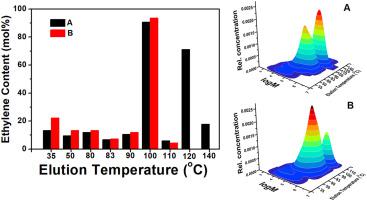Polymer ( IF 4.1 ) Pub Date : 2020-10-06 , DOI: 10.1016/j.polymer.2020.123118 Wei Liu , Mei Hong , Yanhu Xue , Lu Shi , Pei Li , Rui Li , Mingqiang Zhang , Yanjie An , Yuxin Gao , Xiangling Ji

|
Polypropylene (PP) has been commonly used as packaging materials due to the favorable mechanical and optical properties related to its diverse and complex chain microstructure which can be better understood through effective fractionation. In this work, two commercial PP resins (A and B) with similar bimodal melting temperature distribution in the range of 100–160 °C but different ethylene content (9.1–12.3 mol%) are fractionated by preparative temperature rising elution fractionation (P-TREF) and relevant fractions are characterized by a variety of techniques such as high temperature-gel permeation chromatography (HT-GPC), differential scanning calorimetry (DSC), 13C nuclear magnetic resonance (NMR) spectroscopy, Fourier transform-infrared (FT-IR) spectroscopy, and wide-angle X-ray diffraction (WAXD). The chain microstructures of the two resins used as food packaging film exhibit heterogeneity and some differences, which are mainly caused by broad and different distribution of ethylene comonomers. Resin B contains more ethylene units than resin A, and the ethylene units are incorporated into the PP chains in the forms of individual unit or very short segments, resulting in large amount of fractions with relatively low isotacticity and crystallinity that eluted at the temperature range of 35–90 °C. These fractions account for 84.07 wt% of resin B, whereas 59.66 wt% of resin A. The propylene sequences of different isotacticity and crystallinity generated by the insertion of ethylene comonomers in resin B are mainly responsible for its biomodal melting behavior. However, ethylene comonomers tend to insert into the PP chains of resin A in the forms of long polyethylene (PE) blocks and generate propylene−ethylene block copolymers with high crystallizability which can be eluted at high temperatures of 120–140 °C. These fractions constitute 3.16 wt% of resin A, but barely exist in resin B. Moreover, 35.83 wt% of resin A were eluted at 110 °C, whereas only 13.22 wt% of resin B can be eluted at this temperature. These fractions with high isotacticity and molecular weight eluted at high temperatures contribute to the higher flexural modulus of resin A. Both long ethylene blocks and propylene sequences of different lengths contribute to the biomodal melting peaks on the thermogram of resin A.
中文翻译:

两种双峰熔融温度分布的丙烯-乙烯共聚物树脂链微结构的比较
聚丙烯(PP)由于其多样化和复杂的链微结构具有良好的机械和光学性能,因此通常被用作包装材料,通过有效的分馏可以更好地理解聚丙烯。在这项工作中,通过制备温度升高的洗脱分级分离法(P-)将具有双峰熔融温度分布在100-160°C范围内但乙烯含量不同(9.1-12.3 mol%)的两种商用PP树脂(A和B)进行分级分离。 TREF)和相关馏分的特征在于多种技术,例如高温凝胶渗透色谱(HT-GPC),差示扫描量热法(DSC),13C核磁共振(NMR)光谱,傅立叶变换红外(FT-IR)光谱和广角X射线衍射(WAXD)。用作食品包装薄膜的两种树脂的链状微观结构表现出异质性和某些差异,这主要是由于乙烯共聚单体分布范围广泛和差异所致。树脂B比树脂A包含更多的乙烯单元,并且乙烯单元以单个单元或非常短的链段的形式掺入PP链中,导致大量的等规度和结晶度较低的馏分在温度范围内洗脱出来。 35–90°C。这些部分占树脂B的84.07 wt%,而占树脂A的59.66 wt%。通过在树脂B中插入乙烯共聚单体而产生的等规度和结晶度不同的丙烯序列主要负责其生物峰熔融行为。但是,乙烯共聚单体倾向于以长聚乙烯(PE)嵌段的形式插入树脂A的PP链中,并生成具有高结晶性的丙烯-乙烯嵌段共聚物,可以在120–140°C的高温下洗脱。这些级分占树脂A的3.16重量%,但几乎不存在于树脂B中。此外,在110℃下洗脱出35.83重量%的树脂A,而在该温度下只能洗脱出13.22重量%的树脂B。这些具有高全同立构规整度和在高温下洗脱的分子量的级分有助于树脂A的更高的挠曲模量。











































 京公网安备 11010802027423号
京公网安备 11010802027423号